CORAL reefs in shallow waters adjacent to the Australian mainland are considered particularly susceptible to coral bleaching, and also smothering by sediment from turbid water. This was all lamented a week or so ago, including by Sussan Ley, the Federal Environment Minister. Relying on a review of more than 1,000 reports by academics who don’t get out enough, she told the nation that the prognosis for the Great Barrier Reef, and particularly inshore reefs, is very poor. 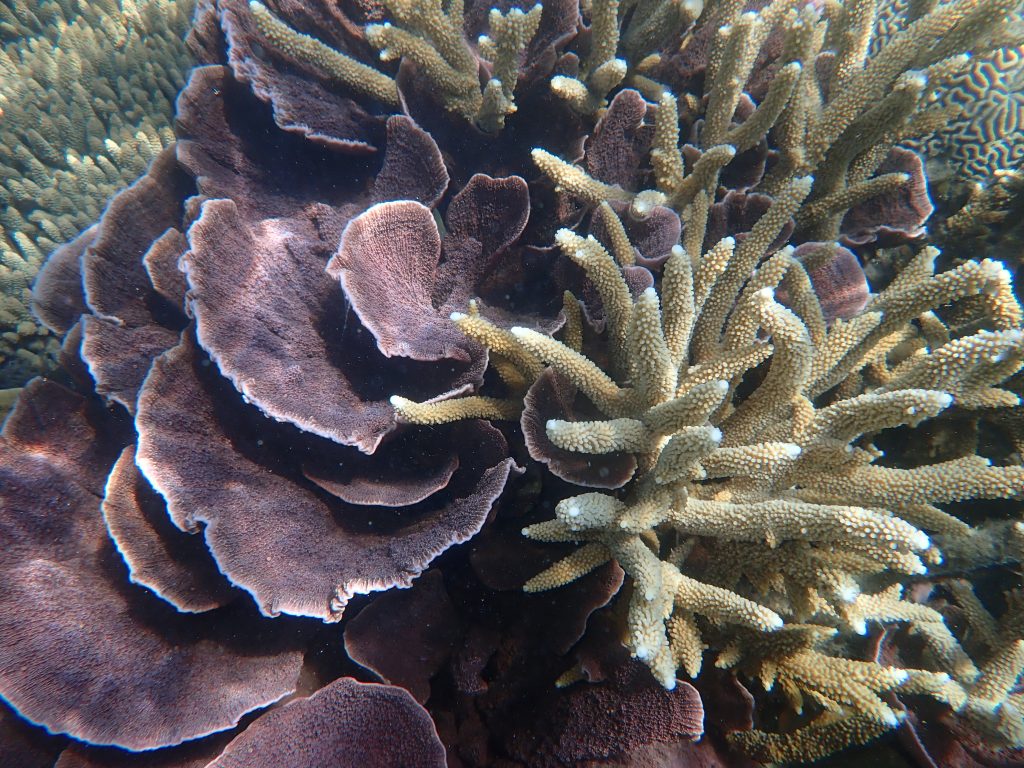
One of the papers that helped shaped this opinion is by Tara Clark (and colleagues) entitled ‘Historical photographs revisited: A case study for dating and characterising recent loss of coral cover on the inshore Great Barrier Reef’ published by Nature (DOI: 10.1038/srep19285).
The historical photographs were taken circa 1890 and 1915 of corals in the vicinity of Stone Island, off Bowen, and they show healthy corals including species of the branching coral Acropora spp.. The historic photographs have Gloucester Island and Gloucester passage as an iconic backdrop.
Tara Clark and colleagues concluded in the peer-reviewed paper published in 2016 that:
Using a combination of anecdotal, ecological and geochemical techniques, the results of this study provide a robust understanding of coral community change for Bramston Reef and Stone Island. In the late 19th and early 20th Century, historical photographs revealed large and abundant living tabular Acropora sp. and massive faviid colonies at Bramston Reef and high cover of both plating and branching Acropora sp. colonies at Stone Island. By contrast in 1994, no living Acropora colonies were found at either location and the majority of the large faviids that featured so prominently at Bramston Reef in c.1890 were dead, covered in algae and/or mud.
And further that:
In 2012 (eighteen years later), Bramston Reef was still characterized by many large faviid colonies, dead and overgrown by algae and sediment, as well as a large number of small living faviid colonies. Yet there was evidence of some small increase in coral cover, primarily driven by tabular Acropora sp. and other genera. In addition, living faviid colonies that appeared to be of equal size to their predecessors were also found in 2012, albeit scarc. At Stone Island, the reef crest was similar to that observed in 1994 with a substrate almost completely devoid of living corals.”
I visited Stone Island late August, and was surprised to find an abundance of Acropora spp. forming both plate and branching colonies. I saw and photographed large pink plate coral on 25th August — some more than 1 metre in diameter — at the reef edge just 30 metres from where Tara Clark and colleagues ended their transect as published in Nature.
I’ve named this coral reef — that Clark and others claim doesn’t exist — Clint’s reef after Clint Hempsall, the underwater cinematography who spent over an hour filming there on 25th August 2019.

This footage will hopefully be included in the film we are making about the inner reefs of the northern Whitsundays: an area that includes Bowen harbour and Stone Island. The footage should also be archived, so that like the 1890 and 1914 photographs it is available as a historic record, a snapshot in time of the state of these reefs.
The two days later, on 27th August, we visited a reef just around the headland from Clint’s reef, in the southern corner of the north-facing bay at Stone Island. The coral coverage here was much more extensive, and this bay also has a view across to Gloucester Island and Gloucester passage.

At this reef, that I’m calling Beige reef, my colleagues Rob McCulloch and Walter Starck estimated close to 100% coral coverage over perhaps twenty-five (25) hectares. I want to return to this reef and map it with my drone (Skido, of course).
There are two dominant coral species at Beige Reef – an Acropora sp. and Turbinaria mesenterina.
The genus Acropora is distinguished by having axial corallites at the tip of each branch, that are different in size, form and often colour from the radial corallites on the same branch. At Beige reef you can easily distinguish the axial corallites on the dominant Acropora species because they are florescent and glow either white or purple. So the branch is beige and the tip white or purple.
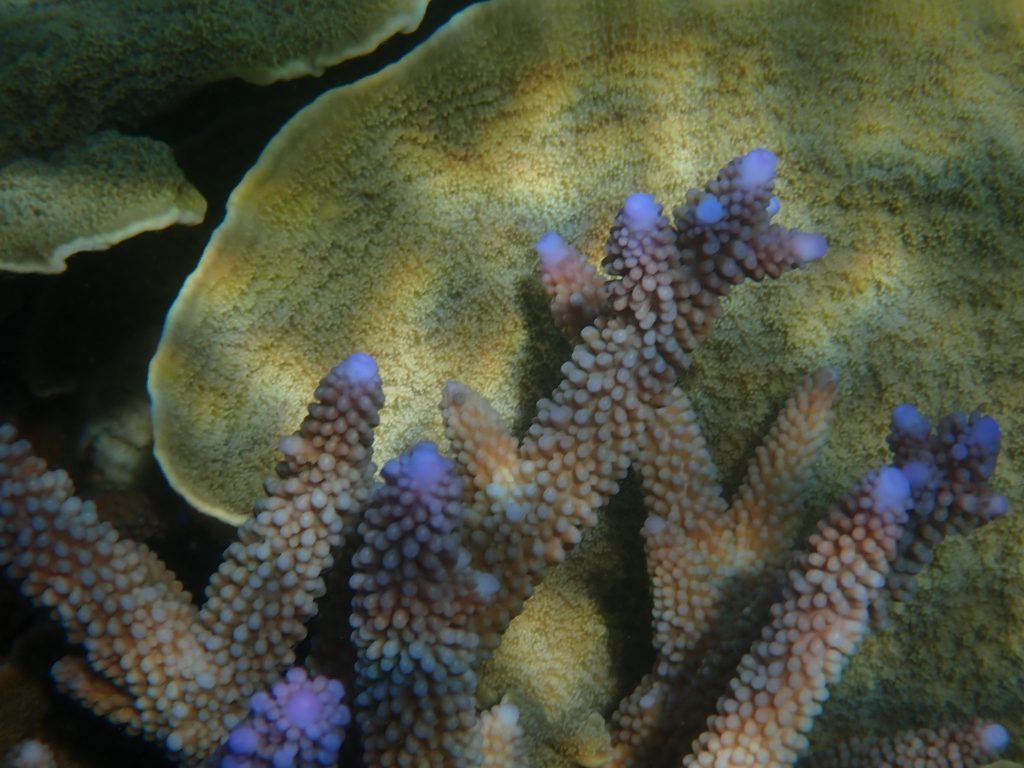
I’ve read that such shallow-water reef-building corals with these photoproteins that fluoresce are more resistant to bleaching when the photoproteins are positioned above the zooxanthellae to protect them from harsh light, as is in the case with this Acropora species at Beige reef. Bleaching occurs when the symbiotic algae (zooxanthellae) are expelled when temperatures become too hot or too cold. Apparently in some deep water corals that fluoresce, the photoproteins are below the zooxanthellae to reflect the light back.
There are apparently over 130 species of Acropora and I would be keen to know the actual species at Beige reef… with these florescent tips.
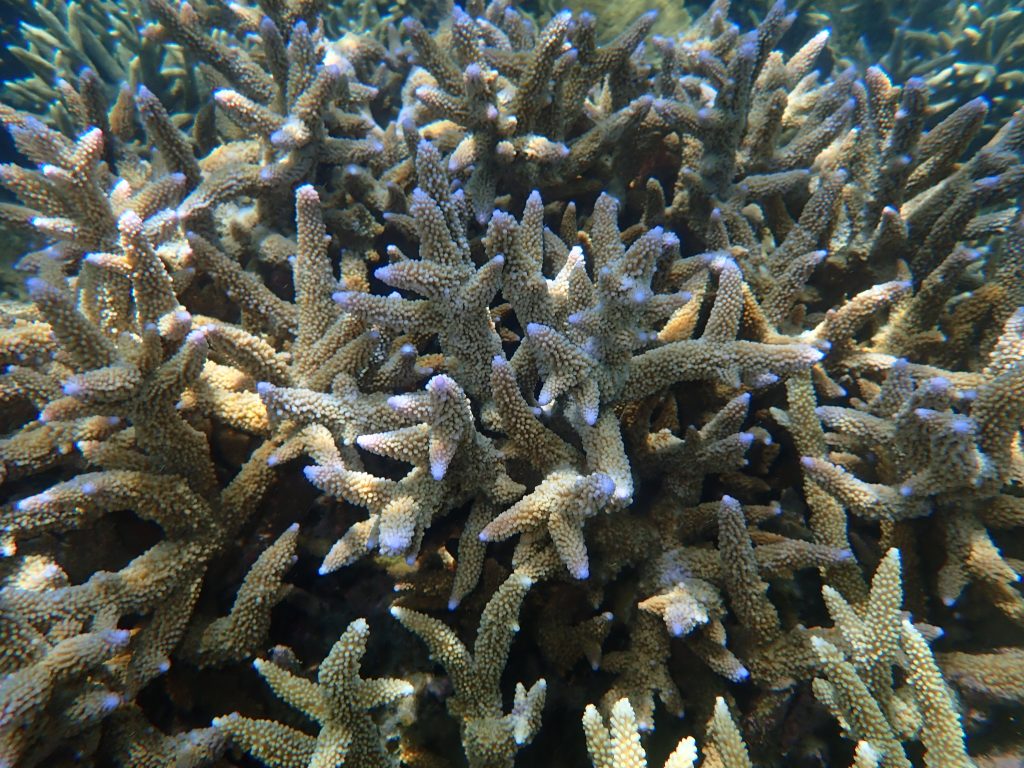
Does anyone want to hazard a guess as to the specific species of Acropora that I have photographed?
It is possible to see the corallite and the tentacles in the close-up photograph.
I’m just learning how to take such pictures that are important for accurate coral identification. The next stage will be to include a scale, for reference … to know the size of the corallites.
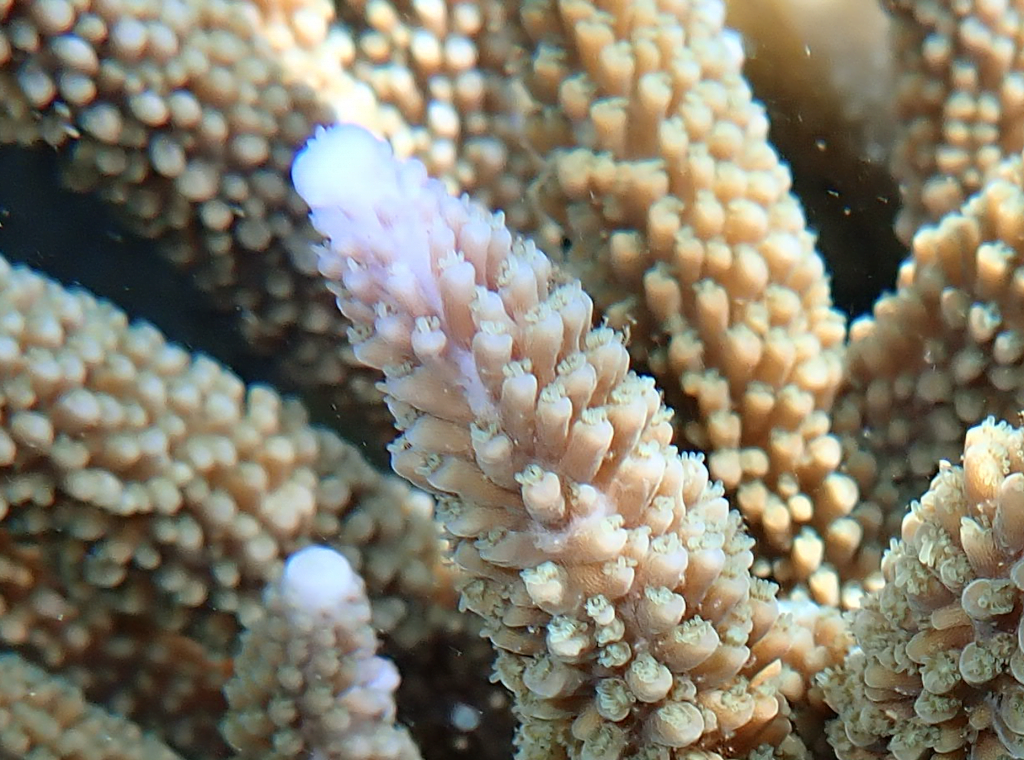
Beige reef is a shallow inshore reef that would be more suspecting to bleaching from both exposure at low tide and also the water heating-up than any of the other reefs I snorkelled off-Bowen. Yet surprisingly there was little evidence of bleaching here — or at the other reefs.
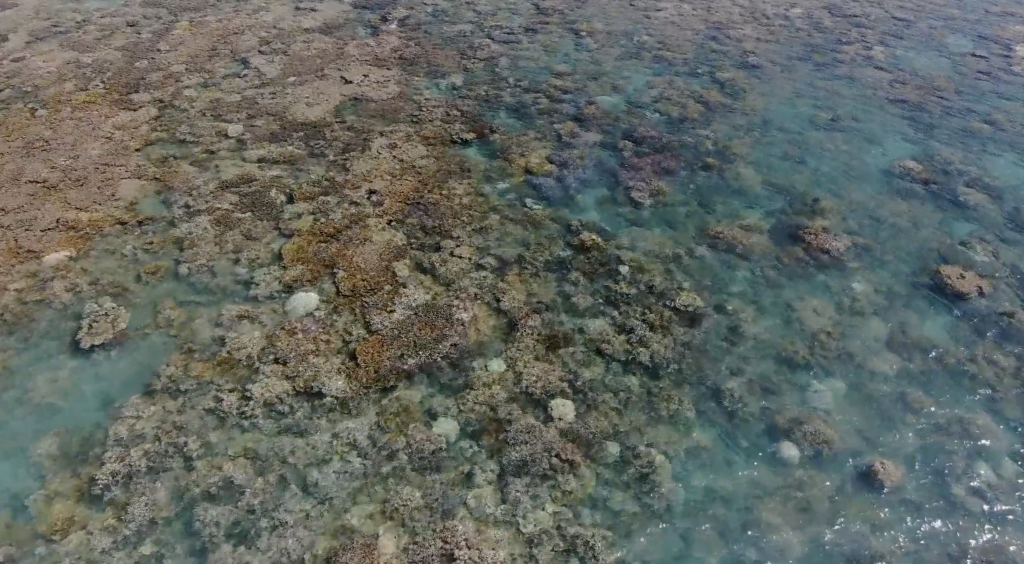
The most damaged of the eight reefs that we snorkelled was at Middle Island, with much of the reef to the south-west of the island reduced to rubble by Cyclone Debbie which struck in early 2017.
The other dominant coral species at Beige Reef is Turbinaria mesenterina. This is a type of foliose coral in the family Dendrophylliidae. The individual polyps fuse to form what are called unifacial laminae, that look something like lettuce leaves made of limestone and all with a white trim.
I’ve read that this coral can self-clean, which is perhaps handy given it lives in relatively turbid inshore waters. Indeed there are mudflats and mangroves at Stone Island, and the Abbot Point coal terminal is not far away, as shown on the map.
These ‘lettuce leaf’ corals were mostly beige in colour, though there were also corals of the same species (T. mesenterina) that were a deep purple, as shown in the second photograph at the very top of this blog post. Both the purple and white forms have the same white trim around the perimeter.

Of course, the colour of a coral has everything to do with the species of symbiotic zooxanthellae, which is the species of symbiotic algae that lives in the coral. So, the same species of coral may be different colours and different species of coral the same colour.
At Beige reef there are a lot of corals that are a delicate beige colour, which is perhaps not for everyone. But I thought it a most beautiful coral reef.
It is a pity that this reef, Beige reef, is denied in the scientific report by Tara Clark and colleagues as published by Nature in 2016. And I find it surprising that Minister Ley can be so negative about the inshore reef because this was not my experience at all having just spent 10 days exploring 8 mostly inshore reefs in the Whitsundays including Beige and Clint Reefs that fringe Stone Island.
UPDATE 06/09/2019: THERE WAS AN ERROR WITH A DATE (I PHOTOGRAPHED THE PLATE CORAL AT CLINT’S REEF ON 25TH, NOT 26TH) AND I’VE MADE A COUPLE OF OTHER EDITS JUST NOW … 1PM ON 6TH SEPTEMBER. THANKS FOR YOUR PATIENCE. ALSO, I’VE ADDED A PHOTOGRAPH. I SHALL STOP NOW. JEN
***
Beige reef has been flown over with my drone, and there is over an hour of underwater cinematography from Clint Hempsall. This footage all needs to be archived … but first some of it will hopefully be included as part of a short film just on Beige reef and then there will be the longer film about all eight reefs. Subscribe at my website so you know when. 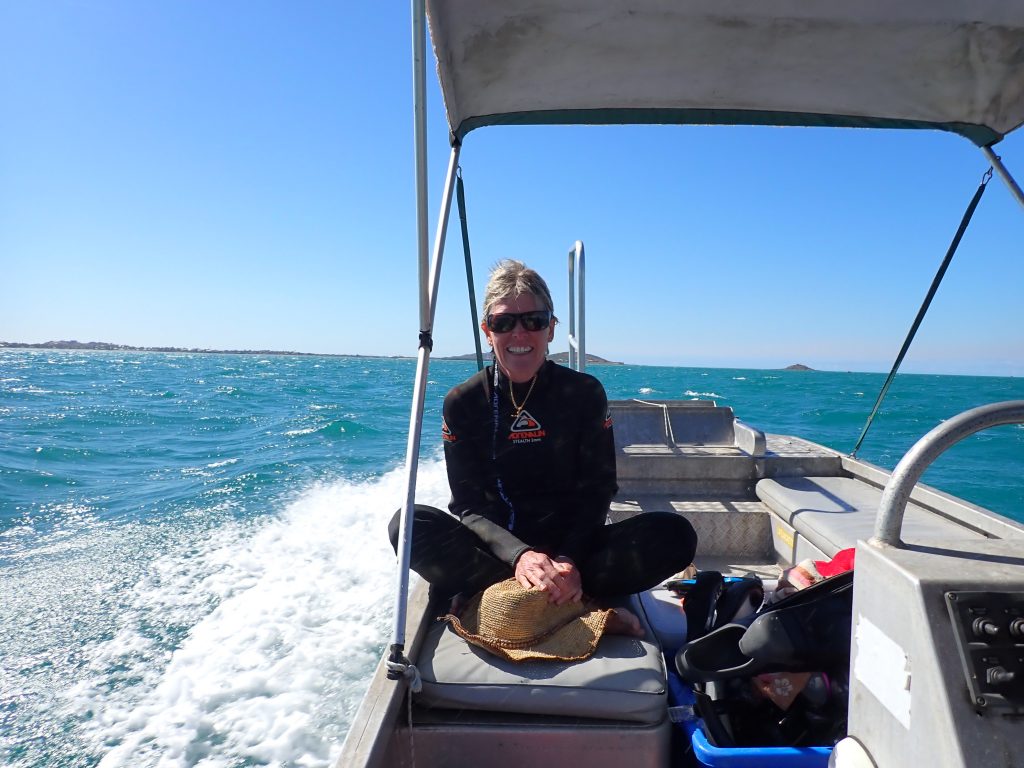

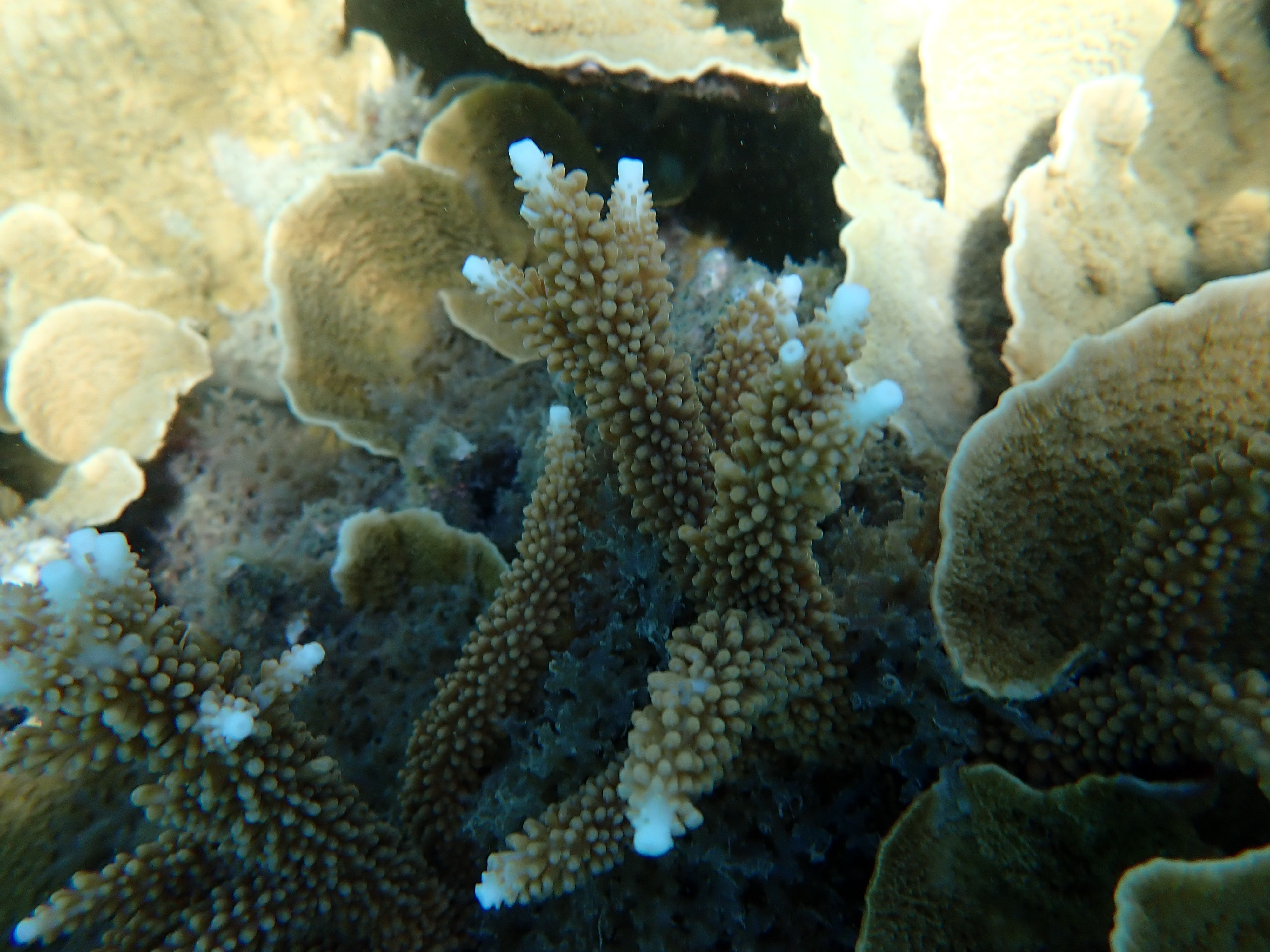
 Jennifer Marohasy BSc PhD is a critical thinker with expertise in the scientific method.
Jennifer Marohasy BSc PhD is a critical thinker with expertise in the scientific method.

One has to wonder if Tara Clark and colleagues actually visited and looked at any of the reefs? Nothing like “boots on the ground” to get the real data. Nice detective work.
I`m not really into poetry, but the quote you chose from Robert Frost’s poem is great. It`s a short poem, but very meaningful and probably my favorite.
Life is full of choices and the choice to go against the “norm” especially for scientists on the whole AGW issue can be very difficult. Thanks for the great work.
Armies of marine biology/ecology people rely on government funding based on their increasingly doubtful claims the reef is endangered. Should they be squirming? Probably not – awaiting the next slick media campaign to drown out this evidence of fraud.
Excellent results. Thank you for sharing Jen Marohasy!
Jennifer
Hopefully you have some drone maps of these areas available for your website here.
I’d like to get an idea of the % area of the region you are discussing.
Great stuff Jen.
In 1985 I did a survey of Hardy Reef, not far away,mostly of the 12 kilometre passage between it & line reef. I was looking for the best spot to sight an outer reef facility for our reef tourist trips.
It had to handle up to 250 people at a time, have good coral to view from our 60Ft imitation submarine coral viewing boat, offer a reasonably safe area for walking on the reef at low tide, & have the lowest tidal flow to make tourist snorkelling & swimming as safe as possible.
I spent 3 days on one occasion, drifting along with the tide, in wetsuit & snorkel gear on one occasion & 2 days on another using scuba gear. You could find anything you wanted in that 12 kilometres, beautiful corals for hundreds of metres, patches of lousy mostly dead coral close by, 6 knots of spring tidal current, or back eddies, with little flow. The coral flat was mostly dead, but some areas were remarkably active, considering that the reef dries about 5Ft on big spring tides. The trick was to fine all the good stuff in one area.
I could easily have taken photos depicting death & destruction of the reef, or beautiful tourist promotional shots with in a couple of hundred metres of each other.
I did on one occasion run a complementary trip for 189 people, consisting of AIMS, GBR marine park authority & James Cook, management, staff & some family. Most of these spent much time telling us there would be no coral to run to with in a few years. This was in 1985 remember. Another pretty lousy academic forecast, simular to their global warming forecasts.
Keep up the good work Jen, I’m not sure you will do anything but earn the respect of very many for your efforts, but they will be of great value in future.
Thanks very much for your efforts in this and your many other issues, Jen. I recently attended the annual conference of the Samuel Griffith Society in Melbourne and froze, but Peter Ridd gave a presentation which was not only well received but enlightened many of the attendees who were not aware of the true state of the GBR and the skulduggery that is inherent I most reef mitigation projects
I know this is well O/T, but Peter Ridd has just commented that a decision on the awards in his case against JCU and unfair dismissal is published.
(https://wattsupwiththat.com/2019/09/05/dr-peter-ridd-wins-1-2-million-judgment-appeal-possible/)
$1.2million against JCU. The uni has 3 weeks to appeal.
I saw a brief interview with Peter earlier this week although I cannot remember the TV details now. He did say that the issue of quality control for scientific research on the GBR is still live and he will have his public say on this. My interest is rekindled.
Great report and amazing photos thanks Dr Jen.
Thank you. Your focus on data driven narrative is so refreshing.
The anti-data fear mongering narratives that consume government and media are wearing thin.
Keep up the good work.
Good article in Saturday’s Australian ! [September 7th, 2019]
The SMH in a small article called Peter Ridd a “climate sceptic”. These people simply cannot help themselves. The power of the public microphone is constantly abused.
By the way, you seem to be attaining quite a skill set for drone flying and applications.
Can you share some of your discovery and advancement in drones?
It is clearly something that is going to be tremendously important in many areas.
Your perspective would be most appreciated.
Peter Ridd was just interviewed on Outsiders.
It seems as if he and Jennifer will continue hard mapping of various areas of the Reef. Gives me great comfort.
The combination of Jennifer’s drone mapping, underwater photography and Peter’s aim of protecting both the Reef and the hinterland farms is very, very welcome.
Jennifer, please publish these sequential results (even abstracts) where they are available to the general public. Drone maps especially. About the most annoying characteristic of the activists is their refusal to release hard data for public consumption.
Hi Jen,
I live in Bowen so am very happy to hear that you’ve found a healthy reef. I managed to get out to ‘beige’ reef last weekend but unfortunately the weather was too rough for me to get in and have a snorkel. Next time I hope.
I’ve had a look at your website and it seems you are fairly cynical of reef science. As a whistleblower yourself it is clear you like to speak up when you find inaccuracies. I therefore feel it necessary to address some of the inaccuracies in your article.
1) I believe your estimate of 25 hectares is an overestimate. Like I said, I haven’t managed to get in and see the reef yet, however, the whole area of the bay is only about 50 hectares, including the deeper water at the mouth of the bay. I am confident from what I could see from boating in the bay last weekend and from my knowledge of coral reefs, that there are not large stands of Acropora across half the bay. I do not deny the existence of these Acropora stands in some areas, but I do think it is important to be accurate in area estimates.
2) I have read the paper by Clark et al. They do not deny the existence of a coral reef in this bay. They are specifically looking at the reef flat/the area that is exposed at low tide (mean low water spring (MLWS) height). They compare this to historical photographs to draw their conclusion because underwater historical photographs are obviously not available. Such comparisons are a useful indicator of changes over time however no one is suggesting that the whole reef has changed in the same way. From the photos you have posted, I am confident that the corals you saw were not in water shallow enough to be exposed at low tide, and therefore out of the scope of comparison from the reef flat photos. This is at least in part based on the morphology of the colony. Both foliose and arborescent colonies would not survive above the MLWS, snapping with any wave action (I know waves are not strong tucked in this area but there is still energy there, particularly in bad weather). In addition, I can also see from the height of the colonies that they are not growing in very shallow water (i.e. shallow enough that they may be exposed).
3) I am doing a PhD in coral physiology and as such, I am not an expert in coral ID but I am competent. I am therefore confident that the second species in your photographs is not Turbinaria mesentarina, or indeed any Turbinaria. Turbinaria has medium polyp size, round corallites and generally a fairly smooth coenosteum. In your coral, the polyps/corallites are too small to see and the coenosteum is very textured. The white trim you mention is common in a lot of corals and is merely the growing edge of the colony, and not definitive of Turbinaria. I do not want to guess at an ID without a close up picture or having seen the corals myself however I see in the Clark paper they do mention a number of genera present in their transects. Perhaps that would be a good place to start your ID.
4) You suggest that it is surprising that there was no evidence of bleaching in these shallow reefs. However, you clearly state that you visited this reef in August, the middle of winter and when the water is coolest. It would be highly unlikely to find thermal bleaching on the GBR at this time of year. If coral cover is as high as you suggest then it seems this reef has largely escaped the recent bleaching events. I am very happy to hear this however this does not mean these bleaching events did not significantly affect other reefs (particularly further north than the Whitsundays).
5) Your comments about “1,000 reports by academics who don’t get out enough” is clearly your opinion but that does not make it factually correct. I have been involved in 2 large scale reef monitoring projects which found a significant decline in the quality of the reef. In both I was in a team of 5 or 6, with 5 or more replicate teams spread down the length of the GBR, with repeated trips at multiple time periods. Each day involved multiple dives and multiple sites, collecting large quantities of data, ultimately representing many 1000s of man hours of ‘boots on the ground’. Whilst I cannot comment for all 1000 of those papers, I can assure you that people are in the water up and down the GBR every day looking at the state of the reef. I can’t make you believe that but I can suggest that the alternative is 1000’s of scientists collaborating on the largest conspiracy ever just to ensure they get more funding. Let me assure you that working on climate change and other anthropogenic effects on the reef is incredibly depressing work. Most of us would much rather spend our time on more positive reef science. I can also assure you that the work in those 1000 articles represents more ‘getting out’ than 10 days on 8 inshore reefs. I am very happy that you have had a positive experience but please don’t assume that those 8 reefs are indicative of the state of the rest of the GBR.
Finally, instead of writing articles complaining of inaccuracies in science, I encourage you to be part of the science. Report what you found, let someone know that the Stone Island reef is doing well. Perhaps we can learn something from it to help with those that aren’t. http://www.gbrmpa.gov.au/our-work/our-programs-and-projects/eye-on-the-reef
I saw Bob Katter, of all people criticising the reef naysayers, challenging them to go to the reef, grab a snorkel or scuba, and have a good hard look at it. He, quite correctly, pointed out that this Chicken Little mentality is really hurting tourism, one of Australia’s biggest ‘exports’.
TH
Thank you for your comment here.
Why do you ascribe bleaching to “climate change” (presumably you mean anthropgenically caused) rather than El Nino events ?
Thank you for your reply in advance.
[I would like to see your mapping posted here as well. Accurate data is always welcome]
Hi Ianl,
Thanks for your response.
Firstly, the mapping. I didn’t do anything fancy for this, I simply measured the area (roughly) using google earth. The whole bay area including the beach, mangroves and exposed reef flat, was about 45 hectares. Clearly, only a fairly small proportion of that area actually has coral.
I have to say I’m not quite sure what you meant by your question. I think you’re asking me why I think bleaching is caused by anthropogenic climate change? I will work from the beginning to explain my reasoning, and hopefully if I have misunderstood the point of your question, this will cover it.
Firstly: I know that prolonged high temperatures disrupt the symbiotic relationship between the symbiodinium/zooxanthelle and coral. I know this because I am working in coral physiology and have read widely (in peer reviewed literature) about the causes and consequences of thermal bleaching. In addition, I have seen bleaching first hand both in an experimental setting where temperatures have been manipulated and in the field during extended periods of excessively hot sea surface temperatures (SSTs). I have no doubt that high temperatures cause beaching.
Secondly: I know that the ‘climate change’ we are seeing now is the result of anthropogenic carbon dioxide (and other greenhouse gas) emissions. There still seems to be an awful lot of debate about whether anthropogenic climate change is real (and I wonder if you and I are on opposite sides of that debate?) however to me, it comes down to two things. 1) carbon dioxide is a greenhouse gas that contributes to the greenhouse effect which maintains life on this planet. Additional gas= additional warming=enhanced greenhouse effect. To me, that is fact and not under debate. 2) Atmospheric carbon dioxide concentrations have increased since the industrial revolution as a result of us burning fossil fuels which produce carbon dioxide. Again, I don’t think that is debatable. https://www.esrl.noaa.gov/gmd/ccgg/trends/
We know burning fossil fuels releases carbon dioxide in our atmosphere and I don’t think anyone can deny that we have been burning them. If we have caused carbon dioxide to increase, we have caused, anthropogenic climate change. Temperatures have changes in the past, naturally, I have no debate about that but the rate is important and the changes we are seeing now are happening faster than historically.
Thirdly: A large proportion of the additional heat from the enhanced greenhouse effect is absorbed by the ocean which means the majority of the increase in temperatures that has happened since the industrial revolution, has happened in the top few meters of ocean.
https://www.climate.gov/news-features/understanding-climate/climate-change-ocean-heat-content#targetText=Waves%2C%20tides%2C%20and%20currents%20constantly,but%20it%20doesn't%20disappear.
This increase in temperature means corals are more frequently being pushed above their maximum thermal tolerance. I can see from all the data (search SST trends – so many depending on location of interest) that the increased SSTs have removed the ‘buffer’ corals had. i.e. – the upper thermal tolerance of corals used to be above the regular temperatures they experienced so when there was an exceptionally warm event, perhaps from el Niño, this didn’t push them above their limit. However, now corals are living closer to their thermal maximum so heat events are now pushing them over their limit into bleaching. Do I believe all bleaching events are caused by anthropogenic climate change? No. As I believe you were suggesting, there are events resulting from natural climate events such as El Niño. While these events have been recorded historically, they were rare. However what we are seeing now is as SSTs rise, corals are bleaching more and more frequently. Even if it isn’t the primary cause every time, it is the underlying stressor which is weakening the system.
I hope that answers your question.
TH
Actually, TH you don’t know that the “climate change we are seeing now is the result of human created CO2”.
And writing articles pointing out inaccuracies is vital, not problematic.
And the fallacy of retroactively applying today’s allegedly accurate ubiqtuos measurements to the past’s inferential and anecdotal measurements is rather significant.
Finally, the silence regarding the the shabby treatment of fellow reef scientists who dare point out inaccuracies in your area of expertise is significant. Particularly at this forum.
One last idea to consider:
That the rejection of skepticism is not actually a strength.
Here is a philospher pondering just that for your consideration.
https://wattsupwiththat.com/2019/09/16/a-philosphers-reflections-on-agw-denial/
So, how many “living” coral reefs are their near the Antarctic and Arctic circles?
What is the ” low-temperature limit” for hard and soft corals?
Is any alleged water temperature rise on the GBR from direct sunlight, contact transmission from a hot atmosphere or perhaps changes to the big circulating ocean currents found along the East coast of Australia?
Any rock-doctors like to explain how large limestone and marble deposits are found at altitudes of over 8000ft above sea level?
What is the average thickness of the limestone Karsts and so forth that make up a lot of real-estate in South-East Asia?
How deeply does a reef have to be subducted to compress it into solid limestone?
How much deeper does it have to be “buried” to metamorphose that limestone into marble?
What is the global mechanism for all this?
Why is there an active coral reef in Moreton Bay? Antarctic polyps?
On a different note, check out the nifty gizmo built by the boffins at QUT, for selectively locating and “spearing” (injecting a toxin) Crown of Thorns Starfish; AUTONOMOUSLY.
Hi Jenny, Ken over at Ken’s kingdom has posted about the BOM weather station at Tarwantin which is the BOM station for Noosa your home town. Interesting !https://kenskingdom.wordpress.com/2019/09/1
QUT “Bot” here:
https://www.qut.edu.au/news?id=135108
See also:
“No matter if the science of global warming is all phony… climate change provides the greatest opportunity to bring about justice and equality in the world.”
Christine Stewart, former Canadian Minister of the Environment
Dr Walter Starck has written about Beige Reef in an article recently published at Quadrant.
https://quadrant.org.au/opinion/doomed-planet/2019/09/reef-alarmists-find-what-they-need-to-find/
He makes mention of the size of the reef, that it extends for about 2 kilometres …
What an insightful article, Jennifer. Thank you very much.
Hi Jen
You are doing a brilliant job, keep it up.
I have been too busy doing my own thing lately and haven’t looked in at your site for a while.
On a recent trip up north I met a young bloke who was a professional scuba diver on a holiday. When I asked whether he would do any diving on the reef, he said, “Oh no, the reef’s all dead, isn’t it?”
Science matters. Evidence matters. Facts trump opinion every time. But opinion gets a lot of media attention. What to do? Just keep plugging away.
Ken
Another bit of scientific evidence that shows why skeptics are justified….and should be celebrated. And why dogmatics, like TH for example, should reconsider a few things.
https://quadrant.org.au/opinion/doomed-planet/2019/09/a-climate-modeller-spills-the-beans/